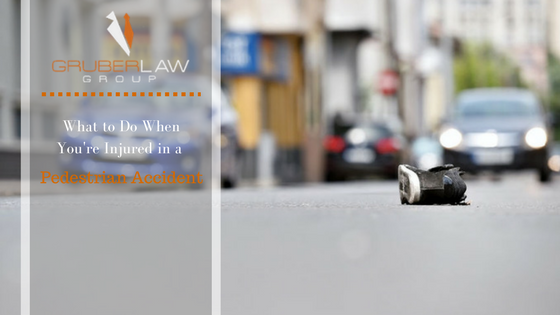 If a fleshy human body versus a two-plus ton hunk of gas-powered metal seems like an unfair fight, then imagine how unfair it feels when people are put at a legal disadvantage after getting injured in a pedestrian accident. Not every city is as progressive as San Francisco when it comes to pedestrian rights, but without the taking the right actions after their injury, even San Franciscans can face an uphill battle with pursuing a personal injury claim against the driver.
If a fleshy human body versus a two-plus ton hunk of gas-powered metal seems like an unfair fight, then imagine how unfair it feels when people are put at a legal disadvantage after getting injured in a pedestrian accident. Not every city is as progressive as San Francisco when it comes to pedestrian rights, but without the taking the right actions after their injury, even San Franciscans can face an uphill battle with pursuing a personal injury claim against the driver.
Therefore, knowing exactly what to do starting the moment you are injured is of critical importance for asserting your right to fair compensation. Make sure to follow each of the steps below in addition to contacting a San Francisco pedestrian accident attorney in order to make sure that your rightful personal injury claim is honored.
1. After Getting Injured in a Pedestrian Accident, Keep Your Cool, and Move Out of the Line of Traffic
The first thing you may want to do after getting hit by a vehicle is hurl every insult in the book at the driver, but keeping your cool is important for several reasons:
- You want to make sure you don’t overlook important tasks you need to take care of in the moments ahead
- You may be seriously injured but not yet feeling its effects; hobbling towards someone in anger will only worsen your condition
- You need to get away from the road ASAP to avoid further injuries; lingering too long could make it look like you disregard your own safety
- Being angry can make you less sympathetic to everyone — bystanders, the driver, insurers, police and anyone else who learns about the incident
- You will want a clear cause-and-effect report of the incident; belittling the driver could confuse the facts later on as people focus on the aftermath rather than the accident itself
2. Talk to The Driver, Keep Them There, Do Not Apologize
While questioning the mental fortitude of the driver could look bad, saying “sorry” for whatever reason looks even worse. Even if you suspect that you may have somehow contributed to the accident, do not admit this to anyone until the full extent of facts are known. Save your personal account of the incident for the police report and your conversations with your attorney.
At the same time, check if the driver is ok if they got into a serious wreck of their own. Tell them in polite terms that they absolutely must stay at the scene because you intend to report the accident.
Although you may be tempted to let the driver off the hook if you do not feel hurt at the time, remember that adrenaline and shock could prevent you from feeling the worst of your injuries, which could be quite serious.
If the driver tries to flee, try to snap a photo of their license plate or car. Make mental notes of the vehicle color, make, model and any distinguishing characteristics you can.
3. Call the Police and Submit a Report
Police reports can only be written at the scene of the accident, and if you wait too long one cannot be written at all. Make sure that police are dispatched to your accident scene and that you are allowed to make a statement for the report. Many pedestrian accident victims neglect to have their side of the story included in the report, which could hurt their case later.
While waiting for police to show up, see if witnesses are willing to make any statements from their viewpoint.
When police arrive, try to avoid making statements like “I have no pain” or inaccurate descriptions of the chain of events; all statements can affect the insurer’s ability to dispute your account if they contradict others made at the time.
4. Capture as Much Information and Photographic Evidence as You Can
The longer you wait after the accident, the more evidence disappears. Make sure to take photos of the accident scene, including photos of:
- The driver’s license plate
- Your injuries
- Any damage to the vehicle
- Physical evidence like tire marks or broken sidewalk pavement
- Multiple angles of the scene, including traffic-directing devices like pedestrian crossing signs, stoplights, stop signs and street lighting
- Get video or audio of witness statements, including the witnesses’s names and addresses, if possible
Since this is a lot of information to get down, do not hesitate to ask for assistance if you are too hurt to move or your hands are too shaky to take decent photos. The driver may even claim you were not hurt since you were moving about right after the accident.
Also get details of the driver, including their name, address, insurance information and any details they are willing to give you.
5. Seek Medical Attention, and Try Not to Turn Down Assistance
You will want your injuries treated immediately. Not all of them will be obvious, such as a fractured rib that does not hurt until the next morning, so you will want a thorough diagnosis and treatment. You will also want to avoid the appearance of not being hurt; the other driver could claim you exaggerated your injuries later since you did not accept emergency care at the accident scene.
Similarly, if someone offers to help carry you or pick up your belongings, carefully consider saying “no,” since turning down help after an accident can indicate non-injury.
6. Immediately Begin Filing an Insurance Claim
Once again, time is of the essence. The longer you wait to file your insurance claim, the less evidence you are likely to have at your disposal and the more counter-arguments can be formed against your claim.
For this reason, you should seriously consider the benefits a San Francisco personal injury lawyer can offer at this stage. They can not only help you file your claim demand like an experienced professional would, but they can also help you gather evidence of fault and your injury costs while defending against any counter-narratives the at-fault driver or their insurer concots.
So, if you have been recently injured in a pedestrian accident, start saving those medical bill receipts, and make sure you contact Gruber law, and an experienced pedestrian accident attorney will provide you with a free consultation and possibly start your claim today.









Leave a Reply